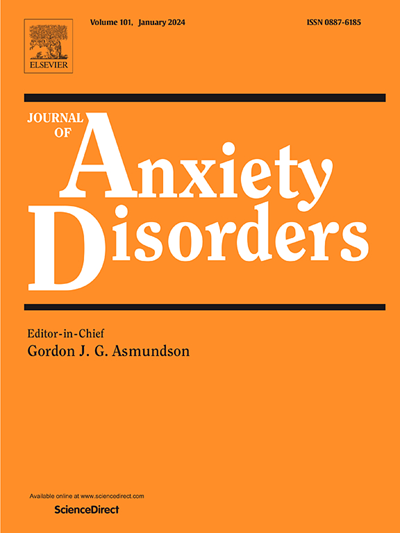针对患有焦虑症或强迫症的儿童和青少年的强化治疗:系统回顾和荟萃分析。
IF 4.5
2区 医学
Q1 PSYCHIATRY
引用次数: 0
摘要
焦虑症和强迫症对青少年有很大的负面影响。认知行为疗法(CBT)作为有效的第一步治疗方法得到推荐和认可,但症状持续和无反应的情况很常见。强化心理治疗在较短的时间跨度内提供更多或更长的疗程,减少疗程间隔。然而,人们对其有效性、特点、可接受性和可行性还缺乏了解。通过对五个数据库进行系统检索,我们获得了四项对照研究和 36 项非对照研究(N=2707),涉及患有原发性焦虑症或强迫症的青少年,其中许多人之前接受过治疗。强化治疗是可以接受的,也是可行的,辍学率较低。组间分析比较了强化治疗与标准治疗(k = 2)或候补治疗(k = 2),结果显示治疗后症状严重程度或缓解程度没有显著差异。强化治疗的非对照组内分析显示,从治疗前到治疗后,症状(k = 47)、缓解(k = 17)、损伤(k = 22)、功能(k = 5)和生活质量(k = 2)都有很大改善,随访效果更大。强化治疗为患有焦虑症或强迫症的青少年带来了希望,因为它有可能提供较高的治疗完成率和与标准 CBT 相当的疗效,帮助患者早日康复并减少整体痛苦。本系统综述/元分析全面概述了强化治疗、其理论考虑因素和实证研究结果。未来的研究性试验应比较标准治疗和强化治疗的有效性,并确定使用强化治疗的最佳人群。本文章由计算机程序翻译,如有差异,请以英文原文为准。
Intensive treatments for children and adolescents with anxiety or obsessive-compulsive disorders: A systematic review and meta-analysis
Anxiety and obsessive-compulsive disorders have a significant negative impact on youth. Cognitive behavioural therapy (CBT) is recommended and established as effective first-step treatment, but persistent symptoms and non-response are common. Intensive psychological treatments deliver more or longer sessions over a shorter time span, with fewer session gaps. However, an understanding of their effectiveness, characteristics, acceptability, and feasibility is lacking. Systematically searching five databases yielded four controlled and 36 uncontrolled studies (N=2707) involving youth with primary anxiety or obsessive-compulsive disorders, many of whom received prior treatments. Intensive treatments were acceptable and feasible, with low drop-out rates. Between-group analyses compared intensive treatment with standard treatment (k = 2) or waitlist (k = 2), revealing no significant post-treatment differences in symptom severity or remission. Uncontrolled within-group analyses of intensive treatments showed large improvements from pre- to post-treatment in symptoms (k = 47), remission (k = 17), impairment (k = 22), functioning (k = 5), and quality of life (k = 2), with larger effects at follow-ups. Intensive treatments show promise for youth with anxiety or obsessive-compulsive disorders by potentially offering high treatment completion rates and comparable outcomes to standard CBT, aiding earlier recovery and reducing overall suffering. This systematic review/meta-analysis provides a comprehensive overview of intensive treatments, their theoretical considerations, and empirical findings. Future RCTs should compare the effectiveness of standard and intensive treatments and identify optimal populations for their use.
求助全文
通过发布文献求助,成功后即可免费获取论文全文。
去求助
来源期刊

Journal of Anxiety Disorders
Multiple-
CiteScore
16.60
自引率
2.90%
发文量
95
期刊介绍:
The Journal of Anxiety Disorders is an interdisciplinary journal that publishes research papers on all aspects of anxiety disorders for individuals of all age groups, including children, adolescents, adults, and the elderly. Manuscripts that focus on disorders previously classified as anxiety disorders such as obsessive-compulsive disorder and posttraumatic stress disorder, as well as the new category of illness anxiety disorder, are also within the scope of the journal. The research areas of focus include traditional, behavioral, cognitive, and biological assessment; diagnosis and classification; psychosocial and psychopharmacological treatment; genetics; epidemiology; and prevention. The journal welcomes theoretical and review articles that significantly contribute to current knowledge in the field. It is abstracted and indexed in various databases such as Elsevier, BIOBASE, PubMed/Medline, PsycINFO, BIOSIS Citation Index, BRS Data, Current Contents - Social & Behavioral Sciences, Pascal Francis, Scopus, and Google Scholar.
 求助内容:
求助内容: 应助结果提醒方式:
应助结果提醒方式:


